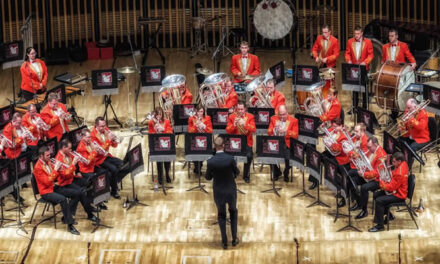The Brevard Sinfonia is an ensemble made up of college-division students at the Brevard Music Center. For many conservatory and university students, it is the first time that they have rehearsed a new program each week, the way that professional orchestras operate. After each of six performances, they turn in their music and are issued the parts for the next week’s rehearsals and concert in Whittington-Pfohl Auditorium. Saturday was the seventh concert of the Sinfonia’s season, so this time the young musicians got to turn in their music and pack to leave for home.
The conductor was JoAnn Falletta, the Principal Guest Conductor of BMC and also Music Director of the Buffalo Philharmonic Orchestra and the Virginia Symphony Orchestra. I love to watch Maestra Falletta conduct; her modest stature is belied by the big arm movements that she uses to provide clear direction. She has a wingspread that makes her a commanding figure, and I do believe she communicates with her elbows as well as her baton, shoulders, arms, and expressive hands.
BMC composition professor David Dzubay wrote “Snake Alley,” the first piece in the program. The composer explained its origin being a trip to Taiwan. The score depicts a scary Taipei taxi ride, a strange marketplace with snakes, monks, and children, a neighboring brothel district, the taxi ride back to the foreigner’s hotel, and the after-images seared on the mind of the tourist who finally gets to sleep. It is a skillfully crafted piece evoking snake hisses, folk songs, and other sounds of the night, punctuated by a lot of percussion. The orchestra provides a sensory overload before the drums fall quiet and a familiar scalar passage restores sanity and decorum. Listening to the performance, I wondered if this orchestra of young people does better with contemporary music than some professional ensembles that have 19th-century concepts of what is music and what is not.
Pianist Norman Krieger joined the Sinfonia to present an elegant, understated performance of Mozart’s Piano Concerto No. 24 in C minor, K.491. Krieger’s clear articulation underscored the operatic drama of the score. The Larghetto shone with fine work by oboe, clarinet, and French horn. The third movement Allegretto, a theme and variations, provided robust piano statements in major keys before returning to the serious C minor key signature to end.
When composers get serious, they often write in C minor. Johannes Brahms was certainly serious when he finally produced his first symphony after struggling for years about following in the footsteps of Beethoven, the titan who had preceded him. Brahms’s Symphony No. 1 in C minor is a worthy successor to Beethoven. Music had made a transition from “classical romanticism” to full-fledged romanticism. It is a tour de force of composition expressing feeling.
Orchestral players must simultaneously focus on the music in front of them, intonation with their section, response to the conductor, integration with the entire orchestra, and projection into the acoustic space of the hall to reach the audience. That is a tall order. Immediately from the initial attack, the violins displayed the big string sound that is so necessary for Brahms. The violas paid attention to the important inner voices that Brahms provides. The cellos impressed with their cohesive playing. The horns responded to Brahms’ many challenges, the entire brass choir was fine in the Adagio, and the woodwinds repeatedly thrilled the audience.
But somehow, I found the performance a bit disconnected. All the pieces were there but in some way had not gelled; there was not a distinctive “orchestral sound” that I could recognize and say, “Ah, that is the Brevard Sinfonia!” I told myself that after all this is a student ensemble; but it is so close to being on a par with many professional orchestras that I longed for that last small element.











